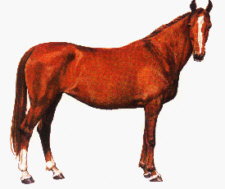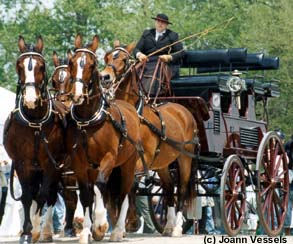

Gelderlander


Introduction: A breed of national importance in Holland (the Netherlands), and a magnificent carriage horse, the purebred Gelderland seems to be less common than it once was. If you have any comments or suggestions, please click here.
Names: Gelderland, Gelderlander. Named after the part of the Netherlands where it originated. I will usually use the shorter form.
Origin: The name of this breed comes from the Dutch province of Gelderland. The breed originated from the crossing of English Thoroughbreds, Norfolk trotters, Holsteins, and Anglo-Normans.
Breeding: This breed can be traced back to mares native to the Gelderland province, crossed with Andalusian, Neapolitan, Norman, and Norfolk Roadster stallions. In the nineteenth century the breed benefited from the introduction of Anglo-Norman, Oldenburg, and Hackney blood. The present trend is to cross this breed with other riding horses, particularly the English Thoroughbred, and the produce has made an important contribution to the development of the Dutch Warmblood.
Description: A horse of the mesomorphic type, with showy good looks, an elegant bearing, flowing action, and effective high-stepping trot.
Body: Wide, with full, deep chest; straight, long back; and short, broad, flat croup.
Color: Chestnut, gray, black, bay or brown, often with white markings.
Head: Long and rather flat.
Hooves: Broad.
Legs: Well-muscled, with the forearm quite long.
Neck: Well-proportioned, muscular and arched.
Profile: Straight.
Shoulder: Nicely sloping.
Size: 15.2-16 hands (1.54 to 1.63 meters). 60-66 inches.
Tail: Set and carried high.
Withers: Fairly prominent and broad, merging with the line of the neck.
Temperament: Placid, docile.
Features:
Uses: Once worked on farms. Now used for leisure riding and in harness, especially light draft work. Able show jumpers. Light draft, riding horse, farm work, good jumper. Used as a riding, farm, or show horse.
Accomplishments:
Curiosities: Many of the decoratively uniformed Dutch Mounted Police accompanying Royal processions at The Hague or Amsterdam, ride Gelderland horses, and the team that pulls the Queen of the Netherlands' coach is likely to be of the same good breed. There have been Gelderland carriage horses in the Royal stalls at Buckingham Palace for many years, although lighter built Cleveland Bays are now being used more. (I don't know how recently this was written, but it was probably in the 1970's to 80's.)
Profiles:
Conclusion: